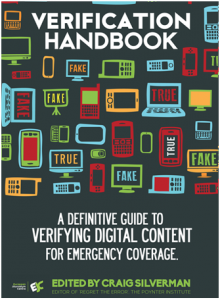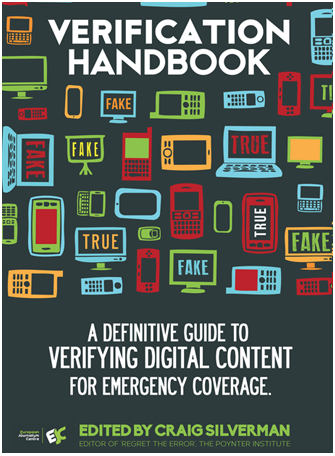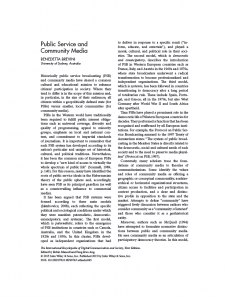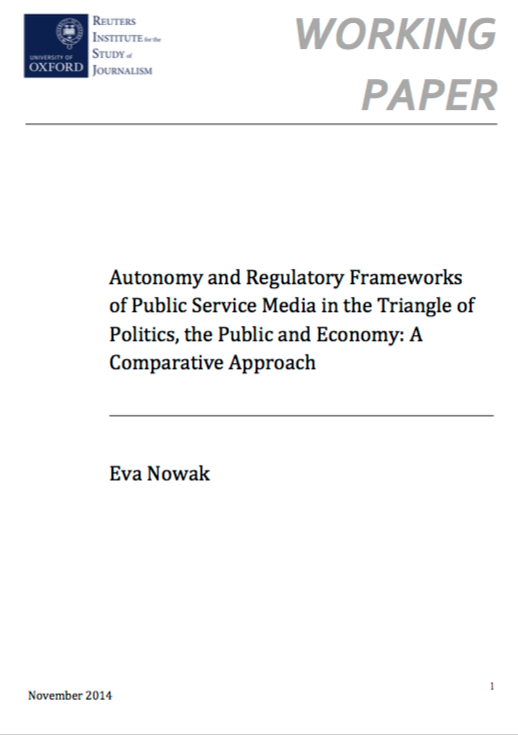Verification Handbook

Guide
This essential resource for journalists and aid providers offers the techniques, tools and step-by-step guidelines for how to deal with user-generated content (UGC) during emergencies.
Produced by the European Journalism Centre and authored by journalists from Storyful, the BBC and Digital First Media amongst others, the handbook gives “actionable advice to facilitate disaster preparedness in newsrooms, and best practices for how to verify and use information, photos and videos provided by the crowd“.
For access to this open source publication, click here.
For more access options, click here.
Public Service and Community Media
JOURNAL
Benedetta Brevini
The International Encyclopedia of Digital Communication and Society
University of Sydney. John Wiley and Sons, Inc
2015
Overview
This article outlines the similarities and differences between public service and community media. It offers a useful overview of their defining characteristics whilst situating them internationally and nationally in terms of their politics and funding mechanisms. The author goes on to explore their contemporary commercial and technological challenges.
To read the full article, click here.
PSM’s Role in the Development of Media Technology and Applications
JOURNAL
NHK and ABC
Zorana Kostic
Department of Media and Communications, University of Sydney, Australia
Published for RIPE@2014, Workgroup 5: PSM and Convergence
Overview
Triggered by the pressures of globalization, the processes of media convergence have split into a two-way communication process consisting of both convergent and-divergent axes. The challenges this duality has created have a continuing and accelerating impact on public broadcasting around the world, and the way it is being experienced by audiences. The more the themes and technology of convergence are exploited in and through the media, the more possibilities appear across multiple digital platforms, which cohere to form a type of techno-postmodernism or techno-cyberism. These convergent processes, where they intersect with public broadcasting have been branded, for want of a better term, as Public Service Media (PSM). The paper analyses these processes through an examination of transformational experiences in the oldest PSBs in the Asia-Pacific region, Japan’s NHK and Australia’s ABC. In this context the NHK and ABC become paradigms of how technological knowledge and social/cultural transformation can be reimagined to benefit the public interest.
Autonomy and Regulatory Frameworks of Public Service Media in the Triangle of Politics, the Public and the Economy
REPORT
Eva Nowak
Reuters Institute for the Study of Journalism
University of Oxford
2014
Overview
“Traditional regulatory frameworks for public service broadcasters in Europe are challenged by developments in media technology, media use, and media economy. European states react in very different ways to these challenges emphasising political, public, or economic objectives in their regulation. This study analyses the influencing factors on PSM regulatory frameworks in France, Germany, Italy, Poland, Spain, Sweden and the United Kingdom”
To read the full article, click here.
Mapping Digital Media: News and New Media in Central Africa
REPORT
Challenges and Opportunities
Marie-Soleil Frère
The Open Society Media Program, December 2012
Abstract
The Democratic Republic of the Congo (DRC) is the largest country in sub-Saharan Africa. Rwanda and Burundi are among the continent’s smallest states. More than just neighbours, these three countries are locked together by overlapping histories and by extreme political and economic challenges. Their populations are overwhelmingly rural and young. In terms of media, radio is by far the most popular source of news. Levels of state capture are high, and media quality is generally poor. Professional journalists face daunting obstacles.
Telecoms overheads are exorbitantly high. In these conditions, new and digital media — which flourish on consumers’ disposable income, strategic investment, and vibrant markets — have made a very slow start. Crucially, connectivity remains low. But change is afoot, led by the growth of mobile internet access.
In this report, Marie-Soleil Frère surveys the news landscapes of DRC, Burundi, and Rwanda. Marshalling an impressive range of data, she examines patterns of production and consumption, the often grim realities of law and regulation, the embryonic state of media policy, the role of donors, and the positive impact of online platforms. Most media outlets now have an online presence. SMS has become a basic tool for reporters. Interactivity gives voice to increasing numbers of listeners. The ease of digital archiving makes it possible to create a collective media “memory” for the first time. Chinese businesses are winning tenders for infrastructure projects.
The report ends with a set of practical recommendations relating to infrastructure, strategies to reduce access costs for journalists and the public, education and professionalisation, donor activity, governance, regulation, and media management.
Media Coverage of Science and Technology in Africa
JOURNAL
Sponsored by UNESCO
Department of Journalism and Communication, Makere University
Principal Investigator: George W. Lugalambi, PhD
2011
Overview
This paper critically analyses the role media has to play in facilitating the public understanding of science and technology across Africa. It does so against the backdrop of little or no previous studies on the subject, with few of them having systematically investigated the volume, quality, scope and perceptions of science and technology coverage.
This article seeks to amend this lack of previous research and explores coverage within the context of the contemporary media landscape of Cameroon, Kenya, Ghana, Namibia, South Africa, and Uganda.
Public policies for public service media
JOURNAL & REPORT
UK and the German policy cases, with warnings and lessons from the USA
A 2010 article by Prof. Peter Humphreys (University of Manchester) that focuses on the impact of new technologies and changing media markets on public service broadcasting. The first part of the article focuses on the impact of new technologies and changing media markets on PSB whilst the second focuses on how to maintain a plurality of content and public service players. US examples and broadcast experiences are used comparatively throughout this paper.
This article was published for the RIPE@2010 conference series.
For the full article, click here
Riding the Wave
JOURNAL
Public Service Television in the Multiplatform Era
La Trobe University, Australia
Media, Culture and Society, Sage Publications, 2009, 31(5), p.807-827
Abstract
Despite their funding dilemmas, public service broadcasters are finding new legitimisation in the digital era. Re-asserting their mainstream status in the fragmenting marketplace, PSB institutions around the world are identifying new ways of delivering public service goals via interactive, on-demand media services across a range of platforms. By repositioning as media content companies, PSBs are forging new kinds of relationships with the public as viewers, users and producers, connecting communities, while also delivering an array of pluralist, personalised services. However, such changes inevitably bring new problems – conflicts with established practices, increased costs, new enemies in the marketplace and the temptation of new commercial revenue streams. Grounded in a series of industry interviews taken from across six case studies and referencing recent literature and policy documents, this article analyses the impact of public broadcasting’s digital rebirth on traditional public service principles.
Beyond Broadcasting: The future of state owned broadcasters in Southern Africa
JOURNAL
Written in 2009, this recommended article, supported by FesMedia Africa, conveys the complicated changes facing state-owned broadcasters in Southern Africa.
These changes include those influenced by the “digitisation of production, distribution and consumption of public interest news and current affairs” and their impact on key broadcast players across the region.
The report is split into sub-reports about the media landscape in individual states and the influence of technological, regulatory and conceptual changes to broadcasting services.
For full access to this open-source article, click here
Public Service Broadcasting
JOURNAL
A new beginning, or the beginning of the end?
Dr. Karol Jakubowicz
Knowledge Politics, retrieved from: http://bit.ly/1NxqHY5
2007
Abstract
In this 2007 paper for Knowledge Politics, the late Karol Jakubowicz explores what the long-term future holds for public service broadcasting in the context of a rapidly changing media landscape. With the move to a digital-only environment in mind, Jakubowicz outlines the benefit of public service broadcasting to the UK and wider European economies, cultures and democracies.
To read the full report, click here.



